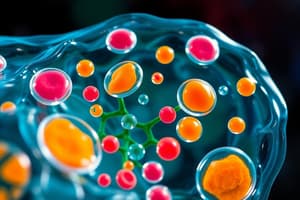Podcast
Questions and Answers
What is the primary energy currency of the cell produced during cellular respiration?
What is the primary energy currency of the cell produced during cellular respiration?
- FADH2
- ATP (correct)
- Glucose
- NADH
What role does the Golgi apparatus play in a eukaryotic cell?
What role does the Golgi apparatus play in a eukaryotic cell?
- Protein modification and sorting (correct)
- DNA replication
- Energy production
- Waste breakdown
Which cellular process occurs in chloroplasts?
Which cellular process occurs in chloroplasts?
- Transcription
- Mitosis
- Photosynthesis (correct)
- Cellular respiration
How do phospholipid molecules contribute to the cell membrane structure?
How do phospholipid molecules contribute to the cell membrane structure?
Which type of cell division produces genetically identical daughter cells?
Which type of cell division produces genetically identical daughter cells?
What is the function of lysosomes within a eukaryotic cell?
What is the function of lysosomes within a eukaryotic cell?
What is the significance of cell signaling in multicellular organisms?
What is the significance of cell signaling in multicellular organisms?
Which of the following is NOT a characteristic of prokaryotic cells?
Which of the following is NOT a characteristic of prokaryotic cells?
Flashcards
Cell Structure
Cell Structure
Cells are the basic units of life, with diverse shapes and sizes.
Prokaryotic vs. Eukaryotic
Prokaryotic vs. Eukaryotic
Prokaryotic cells lack membrane-bound organelles, while eukaryotic cells have them. Examples are bacteria and plants, respectively.
Plasma Membrane
Plasma Membrane
The outer layer of the cell that controls what goes in and out.
Cellular Respiration
Cellular Respiration
Signup and view all the flashcards
Photosynthesis
Photosynthesis
Signup and view all the flashcards
Cell Division (Mitosis)
Cell Division (Mitosis)
Signup and view all the flashcards
Cell Membrane Structure
Cell Membrane Structure
Signup and view all the flashcards
Cellular Diversity
Cellular Diversity
Signup and view all the flashcards
Study Notes
Cell Structure and Function
- Cells are the fundamental units of life, exhibiting diverse shapes and sizes.
- All cells share common features, including a plasma membrane, cytoplasm, and genetic material.
- Prokaryotic cells (bacteria and archaea) lack membrane-bound organelles, while eukaryotic cells (plants, animals, fungi, and protists) possess them.
- The plasma membrane acts as a selective barrier, regulating the passage of substances into and out of the cell.
- Cytoplasm is the jelly-like substance filling the cell, housing organelles.
- Eukaryotic cells contain diverse organelles with specialized functions, including mitochondria (energy production), endoplasmic reticulum (protein synthesis and lipid metabolism), Golgi apparatus (protein modification and sorting), lysosomes (waste breakdown), and vacuoles (storage and support).
- The nucleus houses the cell's genetic material (DNA) and controls cellular activities.
Cellular Processes
- Cellular respiration is the process by which cells break down glucose to produce ATP (adenosine triphosphate), the primary energy currency of the cell.
- Glycolysis, the Krebs cycle, and the electron transport chain are key stages of cellular respiration.
- Photosynthesis is the process used by plants and other organisms to convert light energy into chemical energy in the form of glucose.
- Photosynthesis occurs in chloroplasts, specialized organelles in plant cells.
- Cell division (mitosis and meiosis) is essential for growth, repair, and reproduction.
- Mitosis results in two identical daughter cells, while meiosis produces four genetically diverse daughter cells.
- Cell signaling involves communication between cells through various mechanisms, including hormones, neurotransmitters, and direct contact.
- Receptors on the cell surface or inside the cell receive signals and initiate cellular responses.
Cell Membranes
- Cell membranes are composed of a phospholipid bilayer with embedded proteins.
- Phospholipids have a hydrophilic head and hydrophobic tails, creating a selectively permeable barrier.
- Membrane proteins facilitate transport of substances across the membrane, including channel and carrier proteins.
- Receptor proteins bind to signaling molecules, triggering cellular responses.
- Cell membranes maintain intracellular environments different from the extracellular environment, enabling cell function.
Cellular Diversity
- Cells exhibit a remarkable diversity of shapes and structures.
- Specialized cells perform specific functions, contributing to the organism's overall functioning.
- Muscle cells, nerve cells, and epithelial cells are examples of specialized cells in animal bodies.
- Plant cells possess unique features like cell walls and chloroplasts to support their structure and perform photosynthesis.
- Different types of cells have different proteins and quantities of proteins enabling their variety of roles.
Studying That Suits You
Use AI to generate personalized quizzes and flashcards to suit your learning preferences.




